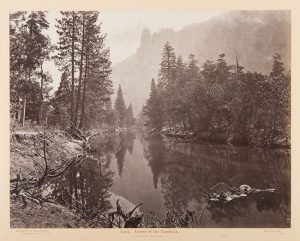
![]() Eadweard Muybridge (born Edward Muggeridge), is best known for his photographic motion studies, which eventually led to the development of cinema technology. Less recognized is his landscape photography, including his first photographic project, undertaken in the Yosemite Valley area in 1867. Trekking the Valley with a team of assistants and pack mules, Muybridge used the cumbersome wet-plate collodion process, which required a portable dark-tent where glass negatives could be sensitized then developed while wet, as well as cameras large enough to accommodate the glass plates. A selection of these photographs was sold as a series of 260 images whose popularity launched Muybridge’s career.
Eadweard Muybridge (born Edward Muggeridge), is best known for his photographic motion studies, which eventually led to the development of cinema technology. Less recognized is his landscape photography, including his first photographic project, undertaken in the Yosemite Valley area in 1867. Trekking the Valley with a team of assistants and pack mules, Muybridge used the cumbersome wet-plate collodion process, which required a portable dark-tent where glass negatives could be sensitized then developed while wet, as well as cameras large enough to accommodate the glass plates. A selection of these photographs was sold as a series of 260 images whose popularity launched Muybridge’s career.
Muybridge visited Yosemite for another six-month trip in 1872, making large and small-plate photographs that earned him international renown. At a time when the frontier was being transformed by farming, mining, and a rapidly growing population, images of unspoiled, majestic natural scenes struck a chord. For this serene view of Loya, the Ahwahneechee name for the geological feature anglicized as Sentinel Rock, Muybridge chose a viewpoint that emphasized the mirror surface of the Merced River, seemingly frozen by the long exposure required by the wet-plate collodion process. Loya, or Sentinel Rock, is a hazy feature in the background, rising into a sky made cloudless by the wet-plate collodion process’s over-sensitivity to blue light.
Muybridge’s composition, which zooms from the foreground into deep space, may have been informed by his familiarity with stereograph technology. During the late 1860s and 1870s, Muybridge published many stereo views of the Yosemite Valley. Small paired photographs mounted to a card meant to be viewed in a special viewer that would produce the illusion of three-dimensionality in a single im![]() age, stereographs required a clear demarcation of space, especially a well-defined foreground and a progression into deep space. Many photographers who made stereographs also applied these compositional elements to their larger view photographs.
age, stereographs required a clear demarcation of space, especially a well-defined foreground and a progression into deep space. Many photographers who made stereographs also applied these compositional elements to their larger view photographs.